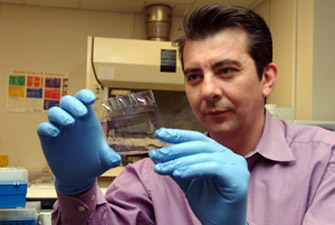- Processes in Living Systems
- Biomolecular Systems and Processes
 Processes of living systems and other biomolecular phenomena are a particularly strong area of research in the Chemical Engineering Department.
Processes of living systems and other biomolecular phenomena are a particularly strong area of research in the Chemical Engineering Department.
Strength in this area follows naturally on having a strong Bioengineering Department and School of Medicine at the UW.
Processes in Living Systems
- François Baneyx: Protein Engineering, Nanobiotechnology, Molecular Biomimetics
- Mary Lidstrom: Genomic & Metabolic Manipulation of Bacteria, Physiological Heterogeneity of Cells
- Hong Shen: Nanomedicine, Immunobiosensing, Systems Biology of Pathogen Recognition
Research in the Baneyx laboratory intersects engineering, biology and nanotechnology: (a) protein (mis)folding into intricate, three-dimensional shapes; (b) genetics, regulation and structure-function relationship of molecular chaperones; (c) exploring the connection between protein (mis)folding and neurodegenerative diseases; and (d) designer proteins to nucleate, organize and assemble nanostructured materials for systems and devices with superior mechanical or opto-electronic properties.
Research in Mary Lidstrom's laboratory is focused on genetic, physiological, and metabolic manipulations of methylotrophic bacteria; capable of growth on methane, methanol, and methylated amines; with the goal of directed manipulation of key metabolic pathways and enzymes. The long-term goal of this research is to develop environmentally sound and economically viable alternatives to current chemical production and cleanup strategies.
Hong Shen’s research bridges engineering and immunology to develop new technologies and examine basic biological mechanisms. Work in the area of nanomedicine addresses engineering of dendritic cells for therapeutics for cancer and autoimmune diseases. Immunobiosensing consists of sensing and defeating pathogen infections, for which the animal kingdom has developed toll-like receptors to deal with the problem. Shen’s group studies the function of toll-like receptors work to differentiate pathogens, through systems biology of pathogen recognition.
Biomolecular Systems and Processes
- Dave Castner: Biomedical Surface Analysis, Surface Characterization & Modification, Biomaterials
- Shaoyi Jiang: Biomolecular Interfaces, Biomaterials, Biosensors
- Lilo Pozzo: Nanomaterials, Biomaterials, Colloids and Polymers
- Buddy Ratner: Biointerfaces, Tissue Engineering & Regenerative Medicine, Biomaterials, Healing
Castner’s research is directed at obtaining detailed information about surface composition and structure of biomaterials and the interaction of biomolecules with those biomaterials. This work takes advantage of recent advances in biochemistry and biomaterials to control chemistry on a local (micrometer) scale undreamed of only a few years ago.
Shaoyi Jiang’s work in the biomolecular area involves the design of superlow biofouling materials. These materials have potential applications in preventing barnacle attachment to ship hulls and new cancer treatments. Jiang’s group also studies protein-surface interactions, with emphasis on protein orientation and conformation. Proteins studied to date include IgG1 and IgG2a, osteopontin (OPN), fibronectin (FnIII7-10), and collagen.
The Pozzo group studies mechanical properties of blood clots, focusing on the relationship between structure and mechanical properties of fibrin networks and blood clots, which, despite its importance and in trauma and numerous diseases (Ex. hemophilia and stroke), remains largely unknown. This work also helps develop synthetic analogs of biomaterials and scaffolds for tissue engineering.
Ratner’s group engineers biomaterials to control biological interactions, of direct applications to biomedical implants. An important concept used in the research considers whether healing and performance of implanted biomaterials might be engineered to be similar to the healing of normal wounds. This leads to the basic biology of wound healing in collaboration with colleagues who are expert in these areas.